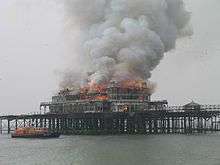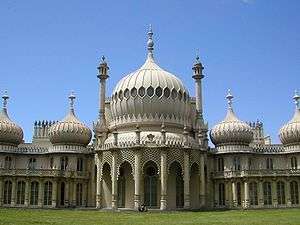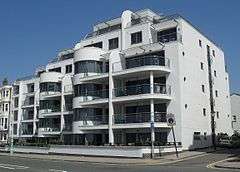West Pier
Coordinates: 50°49′15″N 0°09′04″W / 50.82083°N 0.15111°W
 Remains of the West Pier in 2007 | |
| Official name | West Pier |
|---|---|
| Type | Pleasure Pier |
| Locale | Brighton |
| Design | Eugenius Birch |
| Owner | West Pier Trust |
| Opening date | 6 October 1866 |
| Destruction date | 1975–present |
The West Pier is a pier in Brighton, England. It was designed by Eugenius Birch, opening in 1866 and closing in 1975. The pier was the first to be Grade I listed in Britain but has become increasingly derelict since closure.
The pier was constructed during a boom in pleasure pier building in the 1860s, and was designed to attract tourism in Brighton. It was the town's second pier, joining the Royal Suspension Chain Pier of 1823. It was extended in 1893, and a concert hall was added in 1916. The pier reached its peak attendance during this time, with 2 million visitors between 1918 and 1919. Its popularity began to decline after World War II, and concerts were replaced by a funfair and tearoom. A local company took ownership in 1965, but could not meet the increased maintenance cost, and ultimately filed for bankruptcy. They could not find a suitable buyer, so the pier closed in 1975 and subsequently fell into disrepair.
The West Pier Trust now owns the pier and has proposed various plans to renovate it. Some schemes have been opposed by local residents and the owners of the nearby Palace Pier, who have claimed unfair competition. The pier gradually collapsed during the early 21st century. Major sections collapsed in late 2002, and two fires in March and May 2003 left little of the original structure. Subsequently, English Heritage declared it to be beyond repair. Structured demolition took place in 2010 to make way for the observation tower i360; further structural damage from storms has occurred since.
History
19th century

The West Pier was constructed during a boom in pleasure pier building in the 1860s, during which 22 new piers were erected across Britain.[1] It was designed by architect Eugenius Birch as a place for seaside visitors to enjoy fresh sea air.[2] Some wealthy residents in the nearby Regency Square objected to construction, complaining that the planned toll houses at the entrance would spoil the view of the sea from their homes. It was felt that the pier would have a positive effect on property values in the town, so the pier was approved.[3] Construction began in 1863 and the pier opened to the public on 6 October 1866.[1]

The pier had a length of 1,115 feet (340 m) and a width of 310 feet (94 m) at the pierhead.[4] It was built with cast iron threaded columns screwed into the seabed.[5] The superstructure's ironwork was manufactured by Robert Laidlaw, featuring an "oriental" style. Upon opening, the pier was fitted with gas lamps with ornamental serpent designs, which had been directly influenced by similar examples inside the nearby Royal Pavilion.[1] The pier had ornamental houses, two toll houses and glass screens at the pierhead to protect visitors from the weather.[6] A New Scientist report covering Britain's piers called the pier Birch's "masterpiece".[7]
In 1893, the pierhead was extended under the supervision of Birch's nephew, Peregrine, who added a pavilion with a capacity for 1400 people.[5] After the Royal Suspension Chain Pier was demolished following a storm in 1896, the West Pier became the only one on Brighton's seafront until the construction of the Palace Pier.[8]
20th century

In April 1900, seven sailors from HMS Desperate drowned in bad weather as they approached the pier.[9][10]
By the early 20th century, the earlier priority of good sea air on the pier had been replaced with a desire for public entertainment.[11] The pier reached record levels of attendance in the early 20th century, attracting around 1.5 million visitors between 1910 and 1911. Attendance fell due to the onset of World War I, but resumed afterwards, with around 2 million people visiting between 1918 and 1919.[12]
Competition with the Palace Pier led to a new concert hall, designed by local architects Clayton & Black.[13] The 19th century bandstand was demolished between 1914 and 1916. It was replaced by an eight-sided grand concert hall, constructed from cast-iron arches. It opened on 20 April 1916 with a concert by the King's Royal Rifles silver band, made up of war veterans.[12]
The concert hall had its own in-house orchestra by November, and ticket sales for concerts accounted for 43% of the pier's revenue by 1920.[12] The West Pier was favoured by locals, while the Palace Pier was used more by day trippers.[11] A top-deck entrance was added to the hall in 1932.[5] The pier's central decking was removed during World War II to prevent enemy landings, and its popularity began to decline.[14] On 26 November 1944 a Royal Air Force Hawker Typhoon fighter hit the pier, crashing onto the beach. The pilot sustained head injuries. The Typhoon was one of four aircraft escorting a VIP flight.[15]

The concert hall was converted into a tea room and the theatre redesigned as a restaurant in the early 1950s. A funfair was added around the same time.[14] By the 1960s, the pier was suffering from serious financial difficulties.[14] In 1965, it was bought by a company that owned some seafront hotels and entertainment venues. They had ambitions for the pier but were unable to cope with increasing maintenance costs.[5] Some portions of wood and iron from the pier fell on the beach, and the pierhead was closed in 1970 due to safety concerns.[7][14] The pier was Grade II listed in 1969[16] and the council served compulsory repair notices, but the company was unable to afford them and opted for voluntary liquidation.[7] The remainder of the pier was closed in 1975 when the Brighton Corporation declined to buy it, passing control to the Crown Estates Commissioners.[5]
Restoration

After 1975, various attempts were made to restore the pier. Supporters complained that the council was more interested in developing Brighton Marina.[7] In 1982, the pier became the only one in Britain to be awarded Grade I listed status.[14] The West Pier Trust was formed to save the pier, and bought it from the council in 1983 for a peppercorn fee of £100,[14] though the council also demanded £800,000 required for immediate repairs before it could be opened to the public. A proposal to restore the pier with a 60-metre (200 ft) ferris wheel failed after the backer went bankrupt.[7]
The pier suffered structural damage due to the Great Storm of 1987, and access from the shore was removed for safety reasons in 1991.[16] The West Pier Trust continued to offer regular tours of the pier throughout the 1990s.[11] In 1998, the National Lottery pledged £14 million to restore the pier, but the West Pier Trust was unable to find a suitable partner to help with restoration. The owners of the Palace Pier, who had become financially self-sufficient under their own means, claimed unfair competition. In 2001, English Heritage identified the pier as the most at-risk Grade I listed structure in the United Kingdom.[14]
Decline and damage

In December 2002, the pier partially collapsed during a storm, when a walkway connecting the concert hall and pavilion fell into the sea.[17] The following month, the concert hall in the middle of the pier fell over, leaving the entire structure close to total collapse.[14]
On 28 March 2003 the pavilion at the pierhead caught fire. Fire crews were unable to save the building from destruction because the collapsed walkway prevented them from reaching it. The cause of the fire remains unknown, since fire investigators were unable to access the site for safety reasons,[18] although it is thought to have been arson.[19][20] A more severe fire burned through 11 and 12 May 2003, consuming most of what was left of the concert hall.[14][21] On 23 June 2004, high winds caused the middle of the pier to collapse completely. The following month, English Heritage declared the pier to be beyond repair.[14][22]

Despite these setbacks, the West Pier Trust remained adamant that they would soon begin full restoration work. Retired boxer Chris Eubank criticised the delays in restoring the pier, saying he could raise the money himself in six months.[23] In December 2004, the Trust confirmed the restoration would not be going ahead after their plans were rejected by the Heritage Lottery Fund.[24] The pier was partially demolished in February 2010, partly to make way for the planned i360 observation tower.[25] In February 2014, due to stormy weather, the pier split in half and a large part of the centre fell into the sea.[26] Waves swept away the eastern side of the damaged metal skeleton, which remained after the 2003 fire.[27] A selection of artefacts rescued from the pier is exhibited in the Brighton Fishing Museum.[28] A further section of the pier collapsed in 2016.[29]
The arrival of the i360 has revived interest in building a new West Pier on the site of the original, it would be a contemporary design reflecting the elegance of the original Pier. The West Pier Trust is hopeful that it could be in place by 2026 in time for the piers 160th anniversary.[30]
Media appearances
The pier can be seen in several films, including Oh! What a Lovely War (1968)[11] and Carry On Girls (1973) which was filmed on the pier and in locations nearby in Brighton.[31] It was also prominently featured in the French comedy La Course à l'échalote (1975), starring Pierre Richard and Jane Birkin.[32]
In Nick Cave's novel The Death of Bunny Munro, Bunny's son speculates on a reason for the 2003 fires.[33] The band James filmed the video for "Just Like Fred Astaire" on and around the West Pier.[31]
See also
References
Notes
- 1 2 3 Dobraszczyk 2014, p. 143.
- ↑ Arscott 2012, p. 116.
- ↑ Dobraszczyk 2014, pp. 137,144.
- ↑ "Brighton West Pier". Engineering Timelines. Retrieved 29 April 2015.
- 1 2 3 4 5 Bainbridge 1986, p. 188.
- ↑ Dobraszczyk 2014, p. 144.
- 1 2 3 4 5 "The End of the Pier Show". New Scientist: 299. 4 February 1982.
- ↑ Salzman, L F, ed. (1940). "The borough of Brighton, in A History of the County of Sussex". 7. London: 244–263.
- ↑ "Disaster to Bluejackets – Boat Swamped at Brighton – Seven Seamen Drowned.". News of the World. 15 April 1900.
- ↑ "HMS Bittern". Index of 19th Century Naval Vessels and a few of their movements. Retrieved January 13, 2014.
- 1 2 3 4 Mansfield, Paul (24 June 2000). "Brighton: Oh what a lovely pier!". The Daily Telegraph. Retrieved 1 May 2015.
- 1 2 3 "Concert on the West Pier, Brighton c.1916-8". Camden Town Group. Tate Modern. Retrieved 29 April 2015.
- ↑ "Original West Pier design drawing goes on sale". Brighton Argus. 24 July 2013. Retrieved 29 April 2015.
- 1 2 3 4 5 6 7 8 9 10 "West Pier Factfile". Brighton Argus. Retrieved 29 April 2015.
- ↑ Longstaff-Tyrell, Peter (1999). Destination Fowington – East Sussex military airfields & Allied aircraft incidents. Gote House Publishing Company. ISBN 0-9521297-4-4.
- 1 2 "West Pier". Heritage Gateway. Retrieved 1 May 2015.
- ↑ "Brighton's West Pier collapses". BBC News. 29 December 2002. Retrieved 1 May 2015.
- ↑ "West Pier destroyed by fire". BBC News. 28 March 2003. Retrieved 1 May 2015.
- ↑ "Brighton's Piers - the West Pier". This is Brighton. Retrieved 20 August 2016.
- ↑ "West Pier arson probe". Brighton Argus. 28 March 2003. Retrieved 20 August 2016.
- ↑ "Pier fire flares up again". BBC News. 12 May 2003. Retrieved 1 May 2015.
- ↑ "The West Pier – Introduction". Brighton Argus. Retrieved 29 April 2015.
- ↑ "Eubank wants to rebuild West Pier". BBC News. 29 June 2004. Retrieved 1 May 2015.
- ↑ Clarke, James (16 February 2005). "What now for Brighton's West Pier?". BBC News. Retrieved 1 May 2015.
- ↑ "Clean-up operation for West Pier gets under way". BBC News. 2 February 2010. Retrieved 1 May 2015.
- ↑ "Large chunk of Brighton's West Pier falls victim to the sea". The Argus. Retrieved 5 February 2014.
- ↑ "Brighton's ruined West Pier Pavilion split in two by storm". The BBC. Retrieved 5 February 2014.
- ↑ "Museum Gallery". Brighton Fishing Museum. Retrieved 1 May 2015.
- ↑ "Part of Brighton's West Pier collapses after storm". BBC News. 11 February 2016. Retrieved 12 February 2016.
- ↑ "West Pier's 150th birthday to be celebrated in style". Brighton Argus & Gazette. 5 September 2016. Retrieved 9 October 2016.
- 1 2 "The West Pier in the arts". Brighton Argus. 5 February 2014. Retrieved 1 May 2015.
- ↑ "Films made in the Brighton & Hove area". Brighton on Film. Retrieved 1 May 2015.
- ↑ Cave, Nick (2009). The Death of Bunny Munro. Canongate Books. p. 61. ISBN 978-1-84767-376-3.
Bibliography
- Arscott, David (2012). Brighton, A Very Peculiar History. Andrews UK. ISBN 978-1-908-75929-0.
- Bainbridge, Cyril (1986). Pavilions on the Sea – A history of the seaside pleasure pier. Robert Hale, London. ISBN 0-7090-2790-7.
- Dobraszczyk, Paul (2014). Iron, Ornament and Architecture in Victorian Britain: Myth and Modernity, Excess and Enchantment. Ashgate Publishing. ISBN 978-1-472-41898-2.
External links
| Wikimedia Commons has media related to West Pier. |
- The West Pier Trust, charity which owns the West Pier
- History of the West Pier and its Theatre
- Photos of the West Pier 1980 to 2004

.jpg)
.jpg)
